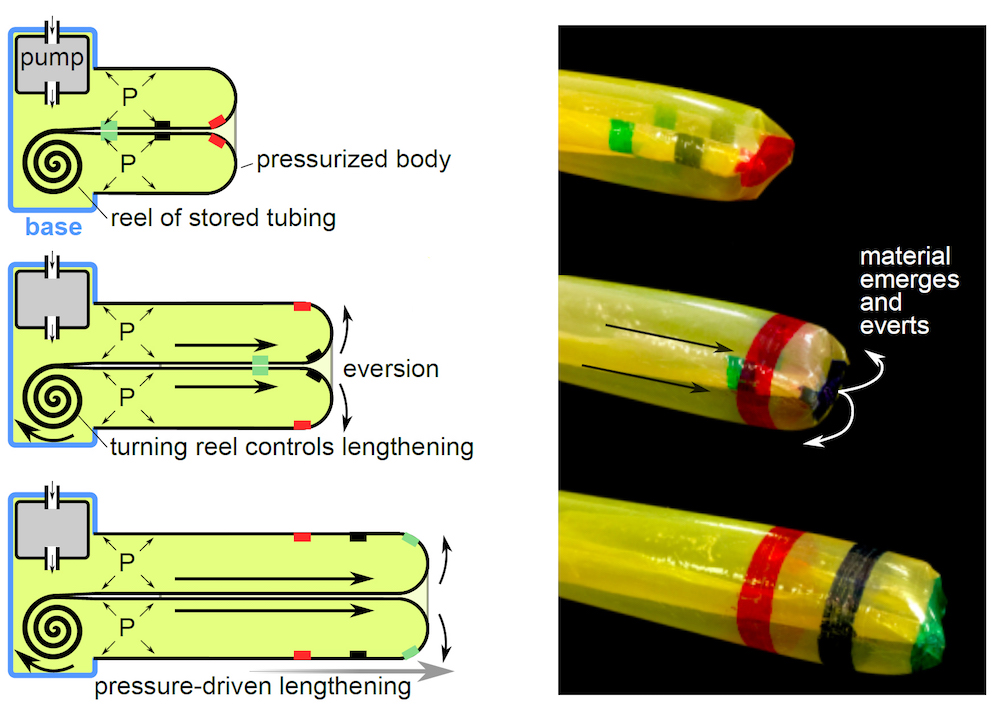Magic Bots: Vine-Inspired Robots Can Grow on Demand
The new soft, flexible robots could one day be used in tight situations, such as to slither through rubble or snake inside the human body, the scientists said.
Previously, scientists have designed robots that copy the way animals and other organisms move, ranging from jointed legs and flapping wings to slithering bodies and undulating tails. [The 6 Strangest Robots Ever Created]
Besides locomotion — the ability to move from one place to another — cells and organisms can navigate their environments through growth. For example, neurons branch outward to incorporate themselves into limbs, and roots grow downward into the soil to absorb water and nutrients.
Study lead author Elliot Hawkes, a roboticist at the University of California, Santa Barbara, was inspired to develop a robot that grows after "watching an English ivy plant, over the course of months, grow around the corner of my bookshelf seeking the sunlight and thinking that in a certain, very slow way, it was going somewhere," he said.
Some advantages of growth over locomotion include the ability to maneuver through narrow spaces and to form potentially useful 3D structures. Until now, however, robots that grow could extend only about one to five times their body length and at speeds of up to about 23.6 inches (60 centimeters) per hour.
Now, Hawkes and his colleagues have developed a robot that can grow thousands of times its body length at speeds of up to 22 mph (35.4 km/h). In comparison, the average man can run about 15 mph (24 km/h) for short periods, and the fastest man in the world, Usain Bolt, can run at up to about 28 mph (45 km/h), according to the National Council on Strength and Fitness.

The newly developed robot is made of soft, flexible polyethylene, the most common plastic in the world. It grows from its tip via internal air pressure, which pushes plastic tubing stored at its base up through the core of its body. The robot is initially about 11 inches (28 cm) long, but can rapidly reach a maximum length of about 236 feet (72 meters), according to the researchers.
Sign up for the Live Science daily newsletter now
Get the world’s most fascinating discoveries delivered straight to your inbox.
"The body doesn't move as the tip extends," Hawkes told Live Science. "That is, you could hold the body of the robot tightly in your hands, and the tip would keep growing."
The inside of the robot is divided into several separate chambers, typically with one on either side of the body. To make the robot steer left or right, the scientists inflate one side more than the other.
The robot is equipped with a camera on its tip, so it can sense light. The camera transmits data to the base of the robot via a cable running through the robot's body. For their study, the scientists had the robot use data from its camera to help it grow toward light, much like a plant would. The camera can also send full-color video to an operator to help them steer the robot, Hawkes said. [Super-Intelligent Machines: 7 Robotic Futures]
In experiments, the robots could grow through narrow gaps and over surfaces covered in glue or nails — the robots did not lose much air pressure when punctured, as the nails partially plugged their own holes, the scientists said. The robots could also pull cables, spray water mist to douse fires, and form 3D structures such as hooks that could be used to turn valves.
In one experiment, one of the robots could apply enough force to lift a 154-pound (70 kilograms) crate, Hawkes said. "We were surprised by how such a simple device could result in such robust movement through challenging environments," he added. "It is nearly impossible to stop it from lengthening."

One potential application for these robots is in search-and-rescue operations, "where the robots could grow through rubble and debris, potentially searching for survivors," Hawkes said. "Unlike small-animal-inspired search-and-rescue robots, the body of the growing robot could act as a conduit to pass oxygen or water to the trapped survivor.
"In a related application, we imagine firefighters growing the robots to the base of a fire to deliver water, as opposed to having to spray from a distance or risk a firefighter's life to get close to the blaze," Hawkes said.
These robots could also find use in minimally invasive surgery. "We have successfully made robot bodies down to 1.8 millimeters [0.07 inches] diameter and are currently working with neurosurgeons," Hawkes said.
Hawkes cautioned that their work "isn't ready yet to fight a fire or perform a brain surgery tomorrow. But we hope it can lead to mature technologies that can make a difference in the world."
The robot currently is handmade. "We hope to automate manufacture of the robots so that dozens of them could cost almost nothing and be used in a search-and-rescue scenario," Hawkes said. "We are also exploring new, more robust materials for the body, such as rip-stop nylon and Kevlar. We also want to continue development of surgical applications, hopefully moving to in vivo testing [experiments in live animals] in the near future."
The scientists detailed their findings online July 19 in the journal Science Robotics.
Original article on Live Science.











